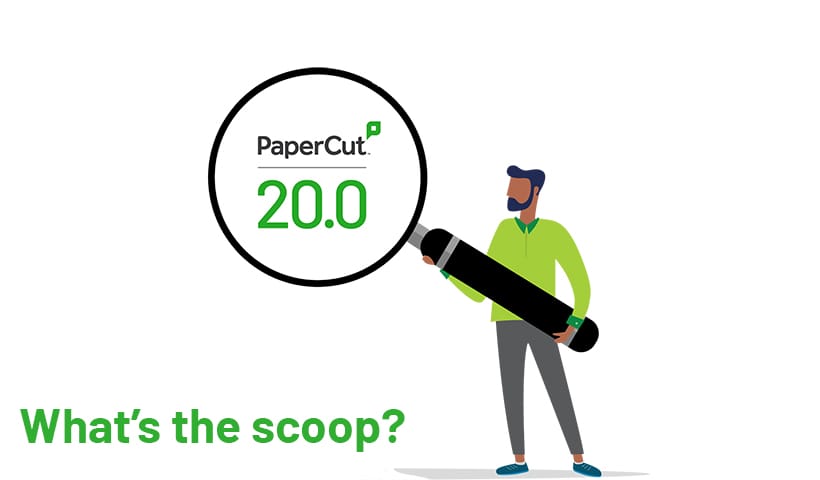Welcome to this brand new series! Seeing as I’m PaperCut’s first tech journalist, what better time to introduce something fresh for the blog than landmark release time?
On 24 June we launched our latest major build for the year - 20.0! Yay!
Now, due to COVID-19, this has taken longer than initially expected. But it’s still a super exciting release with some epic enhancements - oh you better believe that pun was intended.
So to celebrate all these features I’m starting a brand new series - “What’s the scoop on X in 20.0” - where I’ll be zooming in on all the shiny and sparkling nuts and bolts under the hood of this major build.
First up is the huge new Epic integration for the healthcare industry. PaperCut MF 20.0’s Epic integration provides healthcare organizations with features like secure printing, Find-Me printing, print log tracking, and more.
I had a chat with Healthcare product owner Mathew Buttrey about this exciting advancement. He dished the scoop on the Epic integration, and also provided some fascinating insights on healthcare print management.

Healthcare product owner, Mathew Buttrey
PAPERCUT: “Let’s start with an easy one. For those who might not know. Which definitely isn’t me, just for the record, but, uh, for the uninitiated, um, what is Epic?
MAT B: “In a hospital, there are so many functions it’s hard to probably list them all.
“Inpatients, emergency, ambulatory, pharmacy, all of those functions when you go into a hospital, they’re generally run by an application. They’re not using paper these days, it’s all software tracking a patient’s journey through the hospital.
“Just like at a bank or law firm which usually need an application or applications to help with the customer journey, hospitals need an application to monitor patients’ journeys.
“Payments, appointments, patient information, prescribed medicines, general communication, they’re generally all run through an EMR or EHR application (Electronic Medical/ Health Record).
“Epic is one of those applications. It’s a system that runs various functions in a hospital or healthcare organization.”
In a nutshell, what’s the PaperCut MF 20.0 integration with Epic?
“The item we’re addressing is printing from these systems, and more specifically where the print job was generated… some call this “front end” or “back end” printing.
“Back-end printing is where a print job is generated from the EMR itself and the usual case is that job is sent directly to a printer. In some instances when you try and intercept that job it causes problems and can interrupt the print stream.
[podcast url=https://cdn1.papercut.com/web/blog/audio/Whats-the-scoop-on-Epic-in-20-0.mp3]
Mat Buttery explains his Epic integration excitement in 90 seconds (or less)
“So what we’ve built is this integration where you can now configure Epic to send print jobs to a service that provides all of the functions that PaperCut would normally provide like Secure Print Release, Find-Me Printing, the traceability of all print jobs, etcetera.
“In the past, if the jobs were going straight from Epic to the printer there was no ability to engage that PaperCut functionality.
“Customers that use Epic now have the ability to employ all of those PaperCut print management features.”
What are some of the other challenges when tracking back end printing?
“Whether the user name is inserted into the print stream. Often what happens in these systems is the user or the system might make a print job, it might even be a scheduled report, and by the time it gets to either print management or a printer the actual username is just considered generic or ‘system’.
“That’s always been the case. We’ve always been able to print out these back-end systems. It’s just a matter of what data was inserted into the print stream and then if a print management system could pick up that data and make sense of whether that’s a user.
“Then do something with it, whether it be sending it on its way to a printer, not print it, or change it to a greyscale job, or whatever it might be.
Why is print management so important in healthcare?
**“**The answer’s different depending on what region you’re talking about.
“In North America, compliance is king. They have stricter regulations about Protected Health Information (PHI).
“PHI might be something about a patient. The patient has the right to ensure that is protected information. They have the quite strict HIPAA act. If you breach compliance or have a data breach, or breach any regulation, there are heavy consequences.
“So what North American hospitals and health organisations are attempting is to be compliant. Be strict around their data and ensure there are no breaches or PHI leaving their sites.
“Print management is the perfect complementary product, along with the other systems they have in the hospital, to ensure that this data doesn’t leak through an exit point like a printer.
“It’s crucial for them that when you print from one of these systems, the print job doesn’t just automatically sit at the printer for everyone to walk past and view. Or you don’t end up with a pile of paper that’s sitting on the exit tray and you’ve got to sift through everything to find what’s yours.
“When you have a secure print environment the job’s held and waits for you to be at the device so you can release the print job and it’s right there in front of you.
“The amount of printing that happens in these organizations is extraordinary. That means the requirement to have a software application that helps you control or manage printing is more important in a healthcare organization than it may be in a different organization that doesn’t rely on these patient workloads.”

What are the healthcare needs for print management outside of North America?
“It’s often about work efficiency, like a Find-Me print environment. Compliance is still extremely important but not as much as in North America.
“For healthcare organizations in Australia, for example, compliance isn’t so much of an issue. They prioritize workflows, efficiency, and cost savings.
“How much does color printing cost versus monochrome printing? How does a nurse print? Where are the printers situated? How easy is it for personnel to change the job from one printer to another?
“An important need behind the scenes is what PaperCut’s Print Deploy and Mobility Print functionality offer. When you’ve got a lot of contractors and external caretakers, if they enter the hospital, regardless of what device they’re using, how do they print?
“These features allow the visiting medical staff to enter the hospital premises and be given the right drivers at the right time.”
How might hospitals using Epic benefit from this new integration, other than the above-discussed features?
“PaperCut specializes in device-agnostic and cross-platform functionality.
“This is provided by features like Mobility Print as well as our broad range of operating system compatibility and our wide range of embedded MFD functionality.”
You’ve talked about nurses’ and doctors’ print management needs, are there any other members of the healthcare industry who will benefit from this integration?
“There’s a whole bunch of people within a hospital that this appeals to.
“We’ve had conversations with, say, security officers who are finding out, ‘Oh my gosh, when a print job goes from a workstation to a printer and there’s not a unique identifier on it and it just comes out as ‘system’.’
“In those instances, the security officer’s response might be, ‘You’re telling me that I can’t tell who printed that?’ And the hospital IT staff would be saying well that’s the limitation that they have without this type of integration.
“Purchasing officers, and people that understand the finances at a hospital, benefit from this offering because now control is in their hands. They can control their costs. They can control their IT admin staff’s time, who’ll be spending far less time unnecessarily administering print queues because of features such as Print Deploy.
“It provides the same efficiency for administrators because they also now don’t have to administer print queues.
“All these behind-the-scenes operations happen autonomously when people enter sites, locations, campuses, wards. A lot of that functionality happens behind the scenes as well with Print Deploy zones.”
What’s next for Healthcare at PaperCut?
“Healthcare in general right now has a mature roadmap. We’re already partnering with other organizations who are also working with EMR providers like Epic, to make sure any of their workflows that might be interoperating with Epic are also interoperating with PaperCut.
“So for example, faxing. That’s a natural progression to printing. It’s still huge in healthcare. It’s secure and it’s a good way to send information from one individual to a destination, as opposed to single user to user.
“What PaperCut plans to do for faxing is to make that a richer experience using a device’s embedded application. We’ll be looking to make sure that if in fact that particular faxing application is working in some way with Epic and that we can tie into that process as well.
“What we’re trying to do is make sure that all the great work these fax providers have done is accessible on the embedded device. So when you walk up to the PaperCut screen on a copier, the idea is that you’ll authenticate and get this user-friendly experience on the device.
“Rather than having to go to the native functions of the machine, navigate and find where that fax information is.”
Print management for healthcare just got easier
Find out more about the Epic integration in PaperCut MF 20.0.



